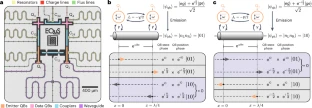Science Daily January 5, 2023
Quantum information transfer between arbitrary nodes is generally mediated either by photons that propagate between them or by resonantly coupling nearby nodes. The utility is determined by the type of emitter, propagation channel and receiver. Conventional approaches involving propagating microwave photons have limited fidelity due to photon loss and are often unidirectional, whereas architectures that use direct resonant coupling are bidirectional in principle but can generally accommodate only a few local nodes. Researchers at MIT have demonstrated high-fidelity, on-demand, directional, microwave photon emission by using an artificial molecule comprising two superconducting qubits strongly coupled to a bidirectional waveguide, effectively creating a chiral microwave waveguide. Quantum interference between the photon emission pathways from the molecule generates single photons that selectively propagate in a chosen direction. This circuit was capable of photon absorption, making it suitable for building interconnects within extensible quantum networks…read more. TECHNICAL ARTICLE

Directional emission in a waveguide QED architecture. Credit: Nature Physics (2023)